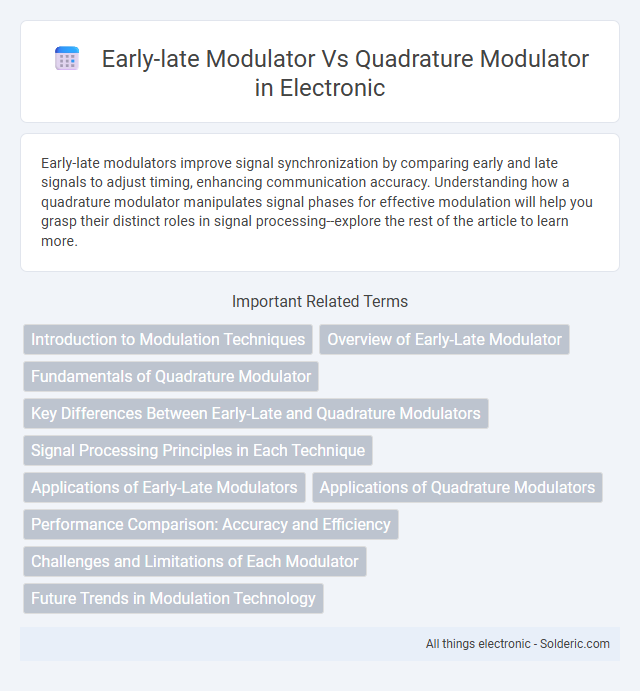Early-late modulators improve signal synchronization by comparing early and late signals to adjust timing, enhancing communication accuracy. Understanding how a quadrature modulator manipulates signal phases for effective modulation will help you grasp their distinct roles in signal processing--explore the rest of the article to learn more.
Comparison Table
| Feature | Early-Late Modulator | Quadrature Modulator |
|---|---|---|
| Function | Timing error correction in symbol synchronization | Frequency translation of baseband signals using I/Q components |
| Application | Symbol timing recovery in digital communication receivers | Modulation and demodulation in RF and digital communication systems |
| Signal Processing | Operates on early and late samples to adjust sampling instant | Combines in-phase (I) and quadrature (Q) signals for modulation |
| Output | Adjusted timing to align sampling with symbol boundaries | Phase-shifted modulated signal at desired carrier frequency |
| Key Advantage | Improves symbol timing accuracy and reduces intersymbol interference | Enables complex modulation schemes like QAM and PSK |
| Complexity | Moderate, focused on timing error monitor and loop control | Higher, involves mixing and phase shifting of signals |
| Typical Usage | PLL loops in synchronization circuits | Transmitters and receivers for modulation/demodulation |
Introduction to Modulation Techniques
Early-late modulators and quadrature modulators are key modulation techniques used in communication systems for signal synchronization and phase shifting, respectively. Early-late modulators primarily aid in timing recovery by detecting phase errors between received and reference signals, ensuring accurate symbol alignment. Quadrature modulators generate complex signals by combining in-phase and quadrature components, enabling efficient transmission of data through amplitude and phase modulation.
Overview of Early-Late Modulator
Early-Late Modulators are timing recovery circuits used in digital communication systems to synchronize the receiver clock with the incoming signal by comparing early and late samples of the signal. This modulator operates by adjusting the sampling instant based on the phase error detected between early and late versions of the received signal, enabling accurate symbol timing recovery. The method provides robust performance in noisy environments, ensuring reliable data recovery in applications like QPSK and BPSK demodulation.
Fundamentals of Quadrature Modulator
Quadrature modulators generate two orthogonal signals, typically a sine and cosine wave, to modulate in-phase (I) and quadrature-phase (Q) components of a baseband signal. This allows precise control of amplitude and phase, enabling complex modulation schemes like QAM and PSK. Your communication system benefits from improved spectral efficiency and reduced distortion by employing the fundamental principles of quadrature modulation.
Key Differences Between Early-Late and Quadrature Modulators
Early-late modulators are primarily used in timing synchronization to adjust phase errors by comparing early and late versions of a signal, enhancing symbol timing recovery in communication systems. Quadrature modulators, on the other hand, generate complex baseband signals by modulating in-phase (I) and quadrature (Q) components separately, enabling efficient transmission of bandwidth-optimized signals such as QAM and PSK. The key differences lie in their functional roles: early-late modulators serve synchronization purposes while quadrature modulators facilitate complex signal modulation, each critical to distinct phases of digital communication processing.
Signal Processing Principles in Each Technique
Early-late modulators utilize timing error detection by comparing early and late versions of a signal to adjust phase or frequency, focusing on pulse position and synchronization. Quadrature modulators employ orthogonal signal components (I and Q channels) to encode amplitude and phase information, enabling complex modulation schemes like QAM. Your choice impacts the modulation accuracy and signal integrity based on whether timing alignment or phase amplitude manipulation is prioritized.
Applications of Early-Late Modulators
Early-late modulators are commonly used in GPS receivers for precise code tracking and synchronization, ensuring accurate timing and positioning data. Their ability to detect timing errors by comparing early and late signal replicas makes them essential for maintaining signal alignment in navigation systems. These modulators are also applied in digital communication systems for carrier recovery and bit synchronization tasks.
Applications of Quadrature Modulators
Quadrature modulators play a crucial role in modern wireless communication systems, such as LTE and 5G, by enabling efficient transmission of complex signals through I/Q modulation. Their ability to separately modulate in-phase (I) and quadrature (Q) components allows for advanced applications like digital signal processing, software-defined radios, and radar systems. You can leverage quadrature modulators to enhance signal fidelity, reduce interference, and improve spectral efficiency in diverse RF applications.
Performance Comparison: Accuracy and Efficiency
Early-late modulators offer robust timing error detection but generally provide lower accuracy in phase estimation compared to quadrature modulators, which excel in precise signal demodulation by processing in-phase and quadrature components separately. Quadrature modulators achieve higher efficiency in complex communication systems due to their ability to handle amplitude and phase variations simultaneously, reducing distortion and improving signal quality. Your choice depends on the application's demands for timing accuracy versus signal fidelity and processing efficiency.
Challenges and Limitations of Each Modulator
Early-late modulators face challenges with timing jitter and sensitivity to noise, which can degrade synchronization accuracy in communication systems. Quadrature modulators encounter limitations related to imbalance errors between I and Q channels, causing signal distortion and spectral leakage. Your system's performance depends on accurately addressing these issues to optimize modulation quality and reliability.
Future Trends in Modulation Technology
Future trends in modulation technology emphasize the integration of advanced signal processing algorithms in early-late and quadrature modulators to enhance synchronization accuracy and signal integrity. Emerging applications in 5G and beyond rely on these modulators' ability to support higher data rates with lower latency, leveraging machine learning techniques for adaptive compensations. Your communication systems will benefit from modulators featuring improved spectral efficiency and robustness against channel impairments, driving next-generation wireless connectivity.
Early-late modulator vs quadrature modulator Infographic

 solderic.com
solderic.com